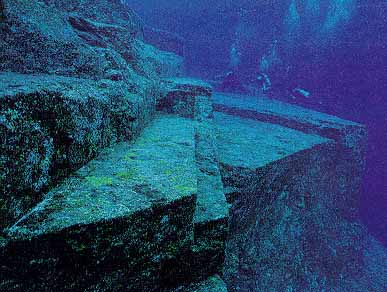Lake Titicaca Underwater Ruins

ABC - April 30, 2003
The ruins of an ancient temple have been found by international archaeologists under Lake Titicaca, the world's highest lake. Dating back 1,000 to 1,500 years ago, the ruins are pre-Incan. The Incas, who built Machu Picchu, believed they originated from the lake, and They regarded the lake as the birthplace of their civilisation, and in their myth, the Children of The Sun emerged out of the waters.
Divers went as deep as 30m in their exploration. A terrace for crops, a long road and an 800-metre (2,600 feet) long wall was also found under the waters of the lake, sited in the Andes mountains between Bolivia and Peru. They have been attributed to the indigenous Tiwanaku or Tiahuanaco people, said Lorenzo Epis, the Italian scientist leading the Atahuallpa 2000 scientific expedition.
The holy temple measures 200m by 50m (660ft by 160ft) almost twice the size of an average football pitch. More than 200 dives were made into the lake, to depths of as much as 30m (100ft), to record the ruins on film.
The explorers found the temple after following a submerged road, in an area of the lake not far from Copacabana town. The complete findings of the 30-member team, backed by the scientific group Akakor Geographical Exploring, are to be published in November. The team also hopes to eventually raise the archaeological remains to the surface.
The lake has long drawn fascination with various legends around it, including one of an underwater city called Wanaku and another of Inca gold lost by the Spanish. The temple exists, but there is no submerged city.
Stories of the lost treasure were enough to draw the famous French oceanographer Jacques Cousteau to explore the lake. However, he discovered only ancient pottery.
The Tiahuanaco culture lived on the shores of the lake before becoming part of the Incan empire, based in Cusco, Peru. The Bolivian Government has said it will provide financial and technical support to preserve the ruins. "This means our civilizations have left more footprints than we had thought," said Antonio Eguino, Bolivia's vice-minister of culture.
Claims of the discovery of a submerged 1,000 year-old temple beneath the waters of Lake Titicaca have sparked controversy in Bolivia. An international group of archaeologists say there is evidence of a temple 200 metres long and 50 metres wide, along with signs of a paved road. The holy site is thought to be from a civilization even older than the Incas - possibly the ancient Tiwanaku culture. However the claims have been met with concern from local people over what they see as intrusive investigations into one of the most holy parts of the Andes.
Eduardo Pareja, a Bolivian scientist who was among those who explored the site, said the remains provided "conclusive proof" of the existence of a pre-Columbian temple. After completing more than 200 dives over a period of 18 days, he said the group were "euphoric" at the find, and called for a fuller investigation of the site. However, Bolivian archaeologist Dr Carlos Ponce is skeptical about the real significance of the find, and says the expedition has yet to provide any concrete proof.
He points to 12 previous expeditions in Lake Titcaca, including one by French explorer Jack Cousteau in 1968 in a submarine - which revealed nothing. Local communities, some of whom are very superstitious, regard the expeditions with suspicion, fearing they will only bring bad luck.
"We think it's a bad sign, and maybe in the future there will be some accidents because people didn't respect the lake", warns Javier Crespi, from Copacabana, one of the towns bordering Lake Titicaca. However the possible discovery of the underwater remains of a 1,000-year old civilization only adds to the aura of legend and mystery which surrounds Lake Titicaca, and is likely to attract more and more sightseers to what is already Bolivia's prime tourist attraction.
 Ancient Aliens - Underwater Worlds History Channel 2010 YouTube
Ancient Aliens - Underwater Worlds History Channel 2010 YouTubeSituated on the Bolivian side of the lake with regular boat links to the Bolivian town of Copacabana, Isla del Sol ("Island of the sun") is one of the lake's largest islands. Geographically, the terrain is harsh; it is a rocky, hilly island. There are no motor vehicles or paved roads on the island. The main economic activity of the approximately 800 families on the island is farming, with fishing and tourism augmenting the subsistence economy.
There are over 180 ruins on the island. Most of these date to the Inca period circa the 15th century AD. Many hills on the island contain agricultural terraces, which adapt steep and rocky terrain to agriculture. Among the ruins on the island are the Sacred Rock, a labyrinth-like building called Chicana, Kasa Pata, and Pilco Kaima. In the religion of the Incas, it was believed that the sun god was born here.
During 1987-92 Johan Reinhard directed underwater archaeological investigations off of the Island of the Sun, recovering Inca and Tiahuanaco offerings. These artifacts are currently on display in the site museum of the village of Challapampa.
Isla de la Luna is situated east from the bigger Isla del Sol. According to legends that refer to Inca mythology Isla de la Luna (moon in Spanish) is where Viracocha commanded the rising of the moon. Ruins of a supposed Inca nunnery occupy the oriental shore.



No comments:
Post a Comment